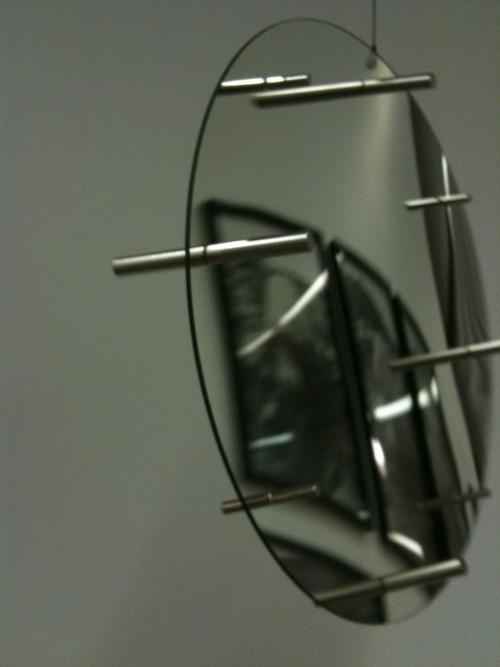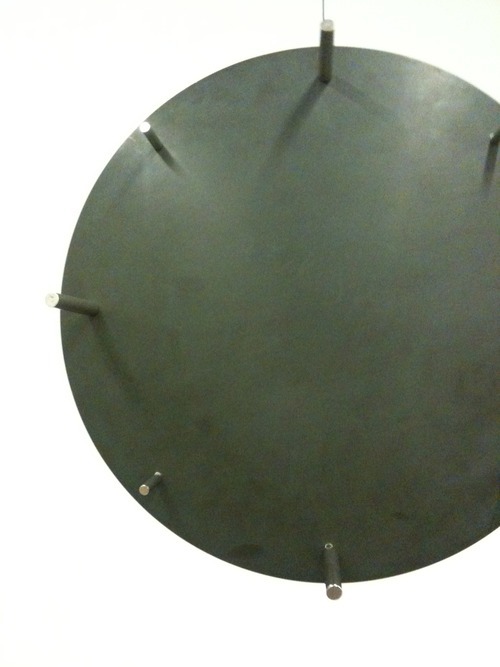the divine comedy is a frankly stunning collection of installations by ai weiwei (last year's unilever artist at the tate bankside, who has not incidentally been arrested (as of april 3) by the chinese government), tomas saraceno, and olafur eliasson (the 2003 unilever artist). having only been to the eliasson installations i can say that they are wondrous in a subtle and unsettling way (about which more below), but the collection of the three artists together is stunning because i cannot imagine how harvard pulled off something so cool without getting terminally stuck in the mud of bureaucracy and administration.
the eliasson installation deserves a fuller post in the future, after i've gone back when the lights are on. i stopped by tonight after a lecture/panel by david brooks and discovered that the installations are powered only between 8am and 5pm each day. this is extraordinarily lame because this series of installations, like much of the other work eliasson has done, explores our perception of light and visual stimulus and deserves to be explored in the off hours when the exhibition space is mostly empty of people.
i openly admit to being a philistine who visits museums because they have good light and great spaces rather than nice art. with few exceptions, i'm not much of a fan of figurative painting or other things like that. what i do like is art that requires technical sophistication in execution, a thorough understanding (even if not a formal one) of perception, and a bit of a sense of humour (even when this is not obvious). hence a deep and abiding appreciation of donald judd (more judd here), robert irwin, fred sandback, michael heizer, richard serra (more serra here), and all those other people. (dia beacon is a great place to go for these artists, not only because their works are concentrated there but also because the museum itself is jawdroppingly gorgeous. the renovation of the beacon building was supervised by ... robert irwin.)
eliasson's work falls into this category. rumour has it that his atelier is staffed by a relatively enormous team of fabricators, which may account for the intricate construction of some of the pieces i saw tonight. but not all the pieces in the divine comedy are extraordinarily expensive, complex, and intricate. what is most delighting is that the best piece is almost the simplest one.
here are two views of it: one concave spherical section, mirrored on one side and penetrated around its edge with rods mounted exactly perpendicular to the surface at the points of mounting. the section is suspended by piano wire from the ceiling so that it rotates unpredictably and slowly. because the rods are perpendicular to the surface and close to the edge, their reflections are only minimally spherically distorted and connect with the non-occluded portion of the rod on the opposite side of the mirror. as such, they appear to penetrate through a clear piece of glass. however, when the section rotates to reflect a part of the room that has rectilinear objects in it, those relatively distant objects are considerably distorted, and the whole gives the appearance of what it actually is: a concave mirror. at other times, when the piece rotates to face a relatively featureless section of wall, it appears like a convex lens. the overall effect is of simultaneously perceiving a mirror, a lens, and a regular piece of glass at the same time; unsettling if you stop to think about it for even a moment. if he'd been able to make the section out of a much thinner material while still maintaining the concavity, the illusion and incongruity would have been total.



what's wondrous about the piece is that it forces the viewer to reconsider what an incredible exercise it is to interpret visual stimulus and come away with a snap identification of the thing being seen: a concave mirror, a piece of glass. donald hoffman's great and very accessible book on visual intelligence goes into some detail about the logic and processing behind these everyday miracles that happen in our heads, but eliasson's work (and especially that one piece described above) does so in the gentle, non-didactic, but insistent manner that is one of the hallmarks of great art.
eliasson is now chair of the Institut für Raumexperiment at the berlin university of the arts. this is a place i would like to visit.
Apr 12, 2011
the divine comedy
Labels: art, craft, design, execution success, neat, process, technology, theory
Subscribe to:
Post Comments (Atom)

No comments:
Post a Comment